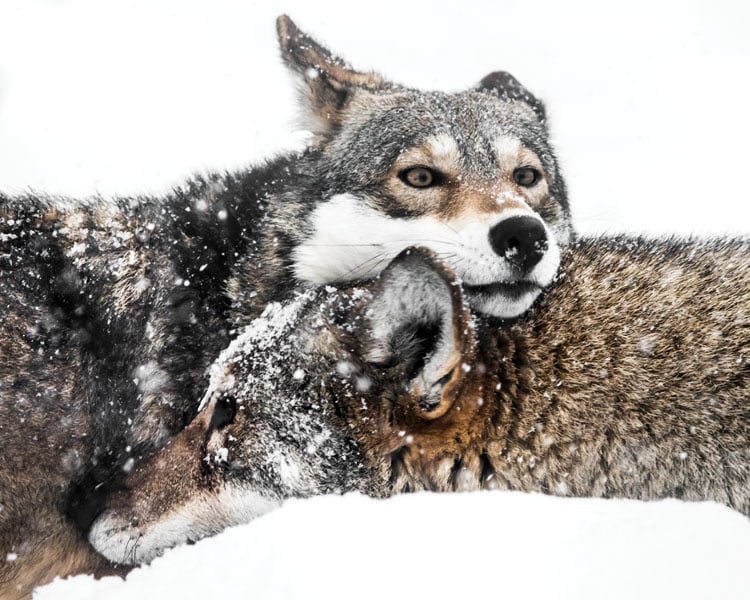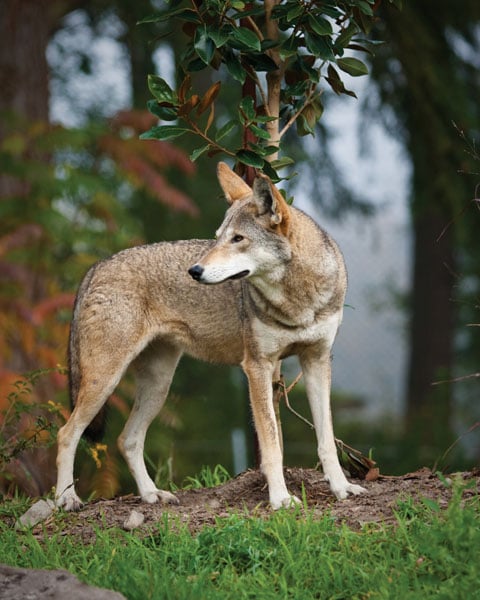I mourn the loss of things that my children and I will never see—whether it’s the mass migration of passenger pigeons or the white blossoms of the American chestnut covering the mountains. Among these wounds there is indeed hope—a hope that can be seen, heard, and felt. For example, one can travel to Cataloochee Valley in the Great Smoky Mountains to hear the majestic, ear-piercing shrill of an elk bugle. This species was once lost to our mountains but is beginning to recover and reclaim its native land.
But I can’t ignore the silence of animals that can no longer be heard in the Smokies. Only a few decades ago, one could still hear the howls and cries of the red wolf. Though the red wolf has been silenced in the Smokies, it can still be heard in the wilds of eastern North Carolina. This swampy stronghold is the only place in the world where endangered red wolves roam free.
The red wolf was nearly driven to extinction in the 1950s through aggressive predator control programs. The red wolf population was decimated so badly that it was declared extinct in the wild in 1980. As a last-ditch effort, the U.S. Fish and Wildlife Service rounded up all of the remaining red wolves to rebuild an “experimental population.”
In 1987, a breeding population of red wolves was released at Alligator River National Wildlife Refuge on an isolated coastal peninsula of eastern North Carolina. The wolves that were released included only four mating pairs. From this first generation, the population now includes over 100 animals.
As the population has grown, the recovery program has faced increasing scrutiny and attacks from some unlikely foes. The North Carolina Wildlife Resources Commission recently passed a series of resolutions that aim to undermine the protections for the red wolf and destroy the species outright. They say that it’s too challenging, too expensive, too contentious, and too late to protect the red wolf. I say, welcome to conservation.
Too challenging?
Conservation is inherently challenging, but since when has that stopped us? What if we had given up on the grizzly, the gray wolf, or the bald eagle? Can you imagine having our national symbol relegated to a mere picture on the back of a quarter? The NC Wildlife Resources Commission is only interested in a future without the red wolf. In my view the real challenge is revamping the apple-polishing good ol’ boy politics that pervade these agencies entrusted to serve the public.
Too expensive?
In 2007, the last year the data was compiled, a total of $1.4 million in federal money was spent on red wolf conservation efforts. This is less than 1% of what was spent on all endangered mammals combined. Compare that to the bald eagle, a recovered and delisted species, which cost $9.5 million.
And just guess how much the state of North Carolina spent on red wolf recovery in 2007? A paltry and embarrassing $1,523. That’s roughly $15 per wild red wolf for the entire year. I would guess the NC Wildlife Resources Commission spends more than $1,500 a year on coffee and donuts for their meetings.
Too contentious?
When European settlers first began their war against the wild in the U.S., the only good predator was a dead one. We believed that with less predators came more game. We soon learned that ecology isn’t quite that simple as disease spread, ranges transformed to dust, and forests were denuded of new growth.
Predator eradication policies of the past have damaged ecosystems and swung nature’s balance in radical directions. Nowhere have these lessons been more evident than in the East. We nearly lost all of our predators and even our prized games species. Today we celebrate the return of the white-tail deer, the wild turkey, and now the elk. But we are just now recognizing the incredible value of predators like the wolf and the cougar to these game populations and to entire ecosystems. For many agencies, though, outdated attitudes toward predators still persist.
Too late?
“We are doomed.” “Things have gotten so bad we are just going to have to live with it. “Species go extinct all the time with no real consequences.“ I have heard all of these statements from professional conservationists. It’s understandable to sometimes feel this way. Aldo Leopold, one of the founding fathers of conservation, wrote, “One of the penalties of an ecological education is that one lives alone in a world of wounds.”
Too often, though, we let these wounds fester rather than mend. Many of today’s conservation interests embrace pessimism, focusing on the magnitude of the challenge rather than the importance of the solution.
It’s not too late for the 100 red wolves in east North Carolina. Do you think the red wolf wishes to pace the confines of a pen alone as the last member of its species? Is this the future we want for the world’s most endangered wolf? The red wolf will fight for its existence, and so must we. It’s never too late to try. We must not lose hope, because this is one wound we can heal.
—
Why is the NC Wildlife Resources Commission (NCWRC) proposing to end the Red Wolf Recovery program, and what can be done?
As of January 2015, the NCWRC passed two resolutions that requested the US Fish & Wildlife Service (USFWS) end the Red Wolf Recovery Program and capture and remove all red wolves from private lands. This resolution threatens the very existence of the species. Over 27 years of recovery would be halted, and the species would once again go extinct in the wild. The reasons cited by the NCWRC are that the Recovery Program has been a failure, the wolves are hybridizing with coyotes, and sea level rise will force the wolves onto private lands. The latter is ironic since the state of North Carolina does not recognize the reality of climate change and passed a law banning any discussion on sea level rise until 2016.
Public comments are crucial. Howl for the wolves: let the U.S. Fish and Wildlife Service know that the red wolves deserve protection and the Recovery Program needs to be continued. Email comments to Cynthia Dohner, Southeast Regional Director of the U.S. Fish & Wildlife Service, at [email protected] and Dan Ashe, Director of the U.S. Fish & Wildlife Service, at [email protected].
Is there any chance of ever bringing the red wolf back to the Smokies and/or southern Appalachians?
Alligator River represents the only location where red wolves have been successfully reintroduced to the wild. Other reintroduction programs have been initiated but failed. Red wolves were released into Great Smoky Mountains National Park in the early 1990s but were recaptured after the wolves left the park boundaries in search of prey. Fearing conflicts with nearby cattle farmers, the program was ended in 1998.
For the red wolf to return to Southern Appalachians, human attitudes must shift. With sea level rise threatening the coastal population, the best hope for red wolves is to be returned to the vast stretches of public lands in western North Carolina.
Are wolves and coyotes interbreeding? Are these coy-wolves a good or bad thing?
While wolves and coyotes share much of their genes, they are classified as separate species and are managed as such. For most of their history coyotes and red wolves did not interbreed as most coyotes inhabited the western states and their migrations were suppressed by healthy wolf populations. As wolves were exterminated from their native range, the range of the coyote expanded. With wolves becoming more isolated, healthy wolf pack dynamics broke down, and wolves in search of mates began to interbreed with coyotes. This interbreeding has caused genetic introgression of coyotes into the red wolf populations and has produced coyote/wolf hybrids sometimes referred to as coy-wolves. Only a healthy population of red wolves that is allowed to expand can overcome the biological invasion of coyotes.








